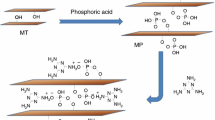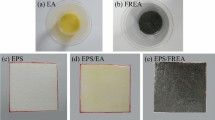Abstract
The article presents the results of research on electrically conductive hard-to-burn composite materials based on polyethylene, graphite, and some flame retardants. It is shown that optimal electrical conducting properties and the flammability rating (V0) in accordance with UL 94 test are achieved by modifying the graphite-containing composite material based on low-pressure polyethylene with ammonium polyphosphate and (or) aluminum hydroxide. It is shown that the percolation threshold of a composite material based on high-pressure polyethylene and graphite is observed at significantly higher values of the mass fraction of graphite. It is concluded that the reduction of the percolation threshold of polyethylene when filled with graphite is facilitated by an increase in the degree of crystallinity of the binder, and the formation of structured continuous conducting clusters in the composite material is observed at lower values of the mass fraction of the filler. As a result, the thermal conductivity and heat resistance of the composite material are increased owing to more efficient delocalization of the supplied heat. A number of electrically conductive hard-to-burn materials were obtained and characterized. These data allow us to directly adjust the values of the specific volume electrical resistance, physical and mechanical properties, heat resistance, and, to a certain extent, flame resistance.







Similar content being viewed by others
REFERENCES
Markov, A.G. and Ivanova, I.A., Fire hazard of static electricity, Proc. 13th Int. Sci.-Pract. Conf. Dedicated to the Year of Safety Culture, Ivanovo, Russia, 2018, pp. 159–162. https://www.elibrary.ru/item.asp?id=38221693&
Blythe, E.R. and Bloor, D., Electrical Properties of Polymers, Cambridge: Cambridge Univ. Press, 2008, chaps. 6–7.
https://www.proektant.kz/content/52.html
Ohsawa, A., Statistical analysis of fires and explosions attributed to static electricity over the last 50 years in Japanese industry, J. Phys: Conf. Ser., 2011, vol. 301, art. ID 012033. https://doi.org/10.1088/1742-6596/301/1/012033
Brevnov, P.N., Kirsankina, G.R., Zabolotnov, A.S., Krasheninnikov, V.G., Novokshonova, L.A., Monakhova, T.V., Lomakin, S.M., and Berlin A.A., The effect of graphite nanoslabs on thermal oxidative destruction of polyethylene, Polym. Sci., Ser. D, 2017, vol. 10, pp. 330–333. https://doi.org/10.1134/S1995421217040050
Nesterov, A.A., Makarova, L.E., Moskalev, V.A., Vahrusheva, U.N., and Vedernikova, K.A., Electrical properties of composite materials based on natural graphite and polyethylene, Sovr. Probl. Nauki Obrazov., 2014, no. 6, p. 173. https://www.scienceeducation.ru/ ru/article/view?id=16161
Sarikanat, M., Sever, K., Erbay, E., et al., Preparation and mechanical properties of graphite filled HDPE nanocomposites, Arch. Mater. Sci. Eng., 2011, vol. 50, no. 2, pp. 120–124.
Pandey, A.K., Singh, K., and Kar, K.K., Thermo-mechanical properties of graphite-reinforced high-density polyethylene composites and its structure-property corelationship, J. Compos. Mater., 2016, vol. 51, no. 12, pp. 1769–1782. https://doi.org/10.1177/0021998316683782
Ogochukwu, U.K. and Nnarue, E.A., Increase in electrical and thermal conductivities of doped polymers dependent on their intrinsic properties; case study: Polymers [polystyrene, polyethylene, poly propylene, nylon 66], doped with graphite, IOSR J. Appl. Chem., 2013, vol. 6, no. 2, pp. 01–04. https://doi.org/10.9790/5736-0620104
Sultana, W.Lv., Rohskopf, A., Kalaitzidou, K., and Henry, A., Graphite-high density polyethylene laminated composites with high thermal conductivity made by filament winding, Express Polym. Lett., 2018, vol. 12, no. 3, pp. 215–226.
Weil, E.D., Fire-protective and flame-retardant coatings. A state-of-the-art review, J. Fire Sci., 2011, vol. 29, pp. 259–296.
Shaw, S.D., Blum, A., Weber, R., Kannan, K., Rich, D., Lucas, D., Koshland, C.P., and Hanson, S., Halogenated flame retardants: Do the fire safety benefits justify the risks? Rev. Environ. Health, 2010, vol. 25, no. 4, pp. 261–305.
Bar, M., Alagirusamy, R., and Das, A., Flame retardant polymer composites, Fibers Polym., 2015, vol. 16, no. 4, pp. 705–717.
Tian, N., Wen, X., Jiang, Z., and Gong, J., Synergistic effect between a novel char forming agent and ammonium polyphosphate on flame retardancy and thermal properties of polypropylene, Ind. Eng. Chem. Res., 2013, vol. 52, pp. 10905–10915.
Ai, L., Yang, L., Hu, J., Chen, S., Zeng, J., and Liu, P., Synergistic flame retardant effect of organic phosphorus-nitrogen and inorganic boron flame retardant on polyethylene, Polym. Eng. Sci., 2020, vol. 60, no. 2, pp. 414–422.
Zheng, Z., Liu, S., Wang, B., Yang, T., Cui, X., and Wang, H., Preparation of a novel phosphorus- and nitrogen-containing flame retardant and its synergistic effect in the intumescent flame-retarding polypropylene system, Polym. Compos., 2015, vol. 36, pp. 1606–1619.
Zheng, Z., Liu, Y., Zhang, L., and Wang, H., Synergistic effect of expandable graphite and intumescent flame retardants on the flame retardancy and thermal stability of polypropylene, J. Mater. Sci., 2016, vol. 51, pp. 5857–5871. https://doi.org/10.1007/s10853-016-9887-6
Shartel, B., Wilkie, C.A., and Camino, G., Recommendation on the scientific approach to polymer flame retardancy: Part 2—Concepts, J. Fire Sci., 2017, vol. 35, pp. 3–20.
Camino, B. and Camino, G., The chemical kinetics of the polymer combustion allows for inherent fire retardant synergism, Polym. Degrad. Stab., 2019, vol. 160, pp. 142–147.
Jonscher, A.K., Universal Relaxation Law, London: Chelsea Dielectrics, 1996.
Author information
Authors and Affiliations
Corresponding authors
Additional information
Translated by Sh. Galyaltdinov
Rights and permissions
About this article
Cite this article
Yevtushenko, Y.M., Goncharuk, G.P., Grigoriev, Y.A. et al. Fire Retardant Electrically Conductive Composite Materials Based on Polyethylene. Inorg. Mater. Appl. Res. 12, 1314–1321 (2021). https://doi.org/10.1134/S2075113321050099
Received:
Revised:
Accepted:
Published:
Issue Date:
DOI: https://doi.org/10.1134/S2075113321050099




